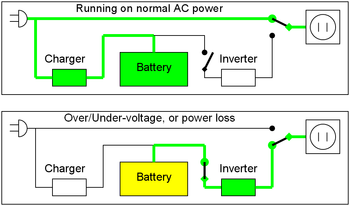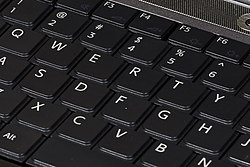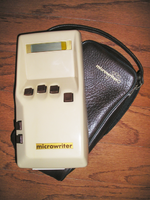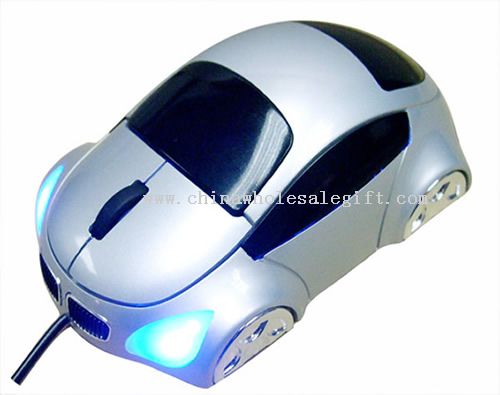Headphones


Headphones (also known as earphones, earbuds, stereophones, headsets, Handsfree phones or by the slang term cans or face plugs) are a pair of small loudspeakers, or less commonly a single speaker, with a way of holding them close to a user's ears and a means of connecting them to a stereophonic, monophonic or binaural audio-frequency signal source such as an audio amplifier, radio or CD player. In the context of telecommunication, the term headset is used to describe a combination of headphone and microphone used for two-way communication, for example with a telephone.
Histor y
y
The telephone earpiece such as the one pictured at the right was common around the turn of the 20th century. From the earpiece developed the headphones. Sensitive headphones were the only way to listen to audio signals before amplifiers were developed.[1]
Very sensitive headphones such as those manufactured by Brandes around 1919 were commonly used for early radio work. These early headphones used moving iron drivers, either single ended or balanced armature. The requirement for high sensitivity meant no damping was used, thus the sound quality was crude. They also had very poor comfort compared to modern types, usually having no padding and too often having excessive clamping force to the head. Impedance varied, but 1,000 to 2,000 ohms was common, which suited both triodes and crystal sets.
When used with early powered radios, the headphone was normally connected to the positive high voltage battery terminal, and the other battery terminal was securely earthed. The use of bare electrical connections meant some users could be shocked if they touched the bare headphone connections while adjusting an uncomfortable headset.
At the time, pre-war headphones were called telephones, or sometimes phones, rather than headphones.
Headsets
Headphones that include a microphone are more commonly known as Headsets, and are more often targeted for communication than recreational listening.[2] Communication headsets include mainly three types, wired telephone, computer and mobile telephone. Telephone headsets are usually connected to a fixed-line (PSTN) telephone terminal, replacing its handset, so users can talk on the phone while they work on other things. Telephone headsets are very commonly used in Call Centers and offices, but are sometimes used at home. Computer Headsets come in two types, standard 3.5 mm plugs for connecting to sound-card of a PC, or USB connection. Both types are very commonly used for VoIP communication, but USB headsets tend to have better sound quality. Gamers might choose to use a headset in order to both hear the game sounds and talk to their fellow gamers. Computer users who employ speech recognition software often use a headset. Mobile phone headsets come in two types, wired and wireless. Wired mobile phone headsets are sometimes called as "Mobile Handsfree", and are basically a pair of earphones with a microphone module connected to the cable. Wireless mobile handsfree also comes in different types, and the most common type nowadays is the Bluetooth headset that rides on the ear. Wireless and wired intercom units used by the coaching staff of professional sports and for broadcast control and event management often employ a headset attachment
Electrostatic
Electrostatic drivers consist of a thin, electrically charged diaphragm, typically a coated PET film membrane, suspended between two perforated metal plates (electrodes). The electrical sound signal is applied to the electrodes creating an electrical field; depending on the polarity of this field, the diaphragm is drawn towards one of the plates. Air is forced through the perforations; combined with a continuously changing electrical signal driving the membrane, a sound wave is generated. Electrostatic headphones are usually more expensive than moving-coil ones, and are comparatively uncommon. In addition, a special amplifier is required to amplify the signal to deflect the membrane, which often requires electrical potentials in the range of 100 to 1000 volts.
Due to the extremely thin and light diaphragm membrane, often only a few micrometers thick, and the complete absence of moving metalwork, the frequency response of electrostatic headphones usually extends well above the audible limit of approximately 20 kHz. The high frequency response means that the low midband distortion level is maintained to the top of the audible frequency band[dubious ], which is generally not the case with moving coil drivers. Also, the frequency response peakiness regularly seen in the high frequency region with moving coil drivers is absent. The result is significantly better sound quality, if designed properly.
Electrostatic headphones are powered by anything from 100v to over 1kV, and are in proximity to a user's head. The usual method of making this safe is to limit the possible fault current to a low and safe value with resistors.





















 Apple Macintosh Plus mice, 1986.
Apple Macintosh Plus mice, 1986. 



